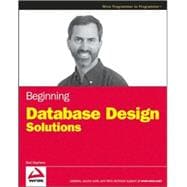
Note: Supplemental materials are not guaranteed with Rental or Used book purchases.
Purchase Benefits
What is included with this book?
| Introduction to Databases and Database Design | |
| Golas of Effective Database Design | |
| Database Types | |
| Relational Database Fundamentals | |
| Database and Design Process Techniques | |
| Understanding User Needs | |
| Translating User Needs Into Data Models | |
| Extracting Business Rules | |
| Normalizing Data | |
| Designing Databases to Support Software Applications | |
| Common Design Patterns | |
| Common Design Pitfalls | |
| A Detailed Case Study | |
| User Needs and Requirements | |
| Building a Data Model | |
| Building a Relastional Model | |
| Extracting Business Rules | |
| Normalization and Refinement | |
| Microsoft Access | |
| MySQL | |
| Advanced Topics | |
| Introdution to SQL | |
| Building Databases with SQL Scripts | |
| Databse Elements | |
| Database Security | |
| Exercise Solutions | |
| Sample Database Designs | |
| Glossary | |
| Index | |
| Table of Contents provided by Publisher. All Rights Reserved. |
The New copy of this book will include any supplemental materials advertised. Please check the title of the book to determine if it should include any access cards, study guides, lab manuals, CDs, etc.
The Used, Rental and eBook copies of this book are not guaranteed to include any supplemental materials. Typically, only the book itself is included. This is true even if the title states it includes any access cards, study guides, lab manuals, CDs, etc.